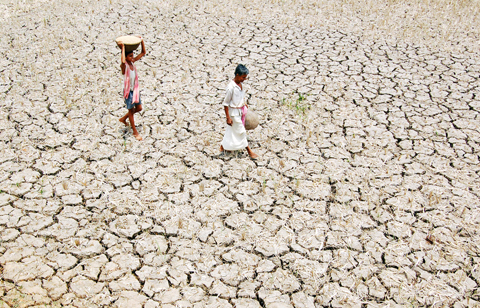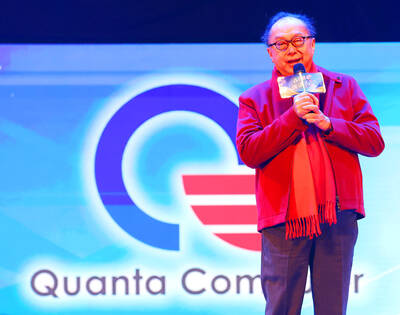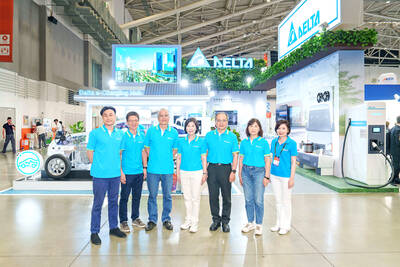Crops are shriveling as India faces the specter of drought, but economists say they are still upbeat about the country’s economic prospects.
They are banking that a strong industrial performance will help offset the impact of the worst monsoon in years in Asia’s third-largest economy.
Analysts have been buoyed by new data showing industrial production jumped by 7.8 percent in June from a year earlier — its quickest pace in 16 months.

PHOTO: AFP
Output was spurred by record low interest rates and government stimulus that have prompted consumers to purchase factory-made products such as cars and refrigerators.
The figures last week came on top of a slew of other economic indicators suggesting India is starting to rebound from the impact of the worst global downturn since the 1930s.
“The domestic economy is slowly but definitely reviving,” said Deepak Lalwani, India director at investment house Astaire & Partners in London.
Even with “the rain gods playing hooky,” a robust industry and service sector outlook “should offset the [economic] hit from agriculture,” said Rajeev Malik, economist at Macquarie Securities.
Malik said he was sticking to his forecast of 7 percent growth for the current fiscal year to March, although he said “a bigger hit to agriculture might warrant a downward revision.”
India’s economy expanded by 6.7 percent last year after growing by a scorching 9 percent for several years in a row.
HSBC economist Robert Prior-Wandesforde, who expects 6.2 percent growth, said the June industrial output number “suggests there is plenty of momentum” outside the agricultural sector.
He said there was “plenty more in the way of positive effects” to come from the central bank’s aggressive interest rate cuts and government stimulus.
“The upside from industrial activity [is] likely to mitigate the negative impact of poor rains,” Goldman Sachs analysts Tushar Poddar and Pranjul Bhandari wrote in a note to clients.
Economists’ optimism about overall prospects stems partly from the reduced role that agriculture now plays in India’s economy — accounting for around 17 percent of GDP, down from 50 percent in the 1950s.
For India’s 235 million farmers, many of them smallholders eking out a living, a single bad monsoon can spell financial disaster, wiping out livelihoods.
India’s official weather map is a mass of red — the color the weather office uses to show “deficient” rains, defined as 20 percent to 59 percent below normal.
Some 177 out of India’s 626 districts are in the grip of drought, with rice crops the worst hit. Only a thin strip along the western coast has received normal rain during this monsoon season, which runs from June to September.

Quanta Computer Inc (廣達) chairman Barry Lam (林百里) is expected to share his views about the artificial intelligence (AI) industry’s prospects during his speech at the company’s 37th anniversary ceremony, as AI servers have become a new growth engine for the equipment manufacturing service provider. Lam’s speech is much anticipated, as Quanta has risen as one of the world’s major AI server suppliers. The company reported a 30 percent year-on-year growth in consolidated revenue to NT$1.41 trillion (US$43.35 billion) last year, thanks to fast-growing demand for servers, especially those with AI capabilities. The company told investors in November last year that

Intel Corp has named Tasha Chuang (莊蓓瑜) to lead Intel Taiwan in a bid to reinforce relations between the company and its Taiwanese partners. The appointment of Chuang as general manager for Intel Taiwan takes effect on Thursday, the firm said in a statement yesterday. Chuang is to lead her team in Taiwan to pursue product development and sales growth in an effort to reinforce the company’s ties with its partners and clients, Intel said. Chuang was previously in charge of managing Intel’s ties with leading Taiwanese PC brand Asustek Computer Inc (華碩), which included helping Asustek strengthen its global businesses, the company

Taiwanese suppliers to Taiwan Semiconductor Manufacturing Co. (TSMC, 台積電) are expected to follow the contract chipmaker’s step to invest in the US, but their relocation may be seven to eight years away, Minister of Economic Affairs J.W. Kuo (郭智輝) said yesterday. When asked by opposition Chinese Nationalist Party (KMT) Legislator Niu Hsu-ting (牛煦庭) in the legislature about growing concerns that TSMC’s huge investments in the US will prompt its suppliers to follow suit, Kuo said based on the chipmaker’s current limited production volume, it is unlikely to lead its supply chain to go there for now. “Unless TSMC completes its planned six

Power supply and electronic components maker Delta Electronics Inc (台達電) yesterday said it plans to ship its new 1 megawatt charging systems for electric trucks and buses in the first half of next year at the earliest. The new charging piles, which deliver up to 1 megawatt of charging power, are designed for heavy-duty electric vehicles, and support a maximum current of 1,500 amperes and output of 1,250 volts, Delta said in a news release. “If everything goes smoothly, we could begin shipping those new charging systems as early as in the first half of next year,” a company official said. The new